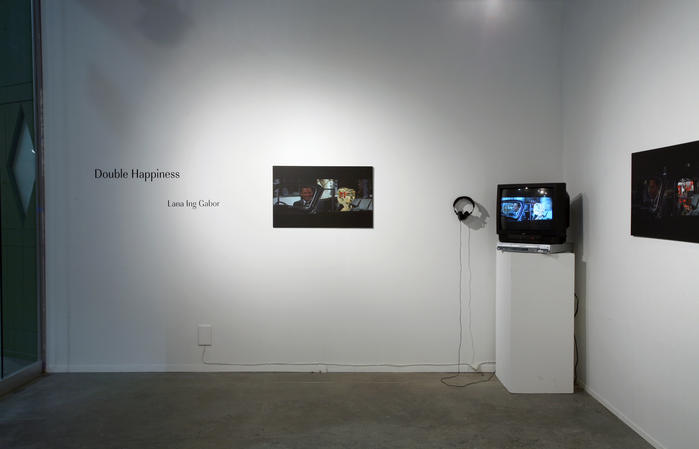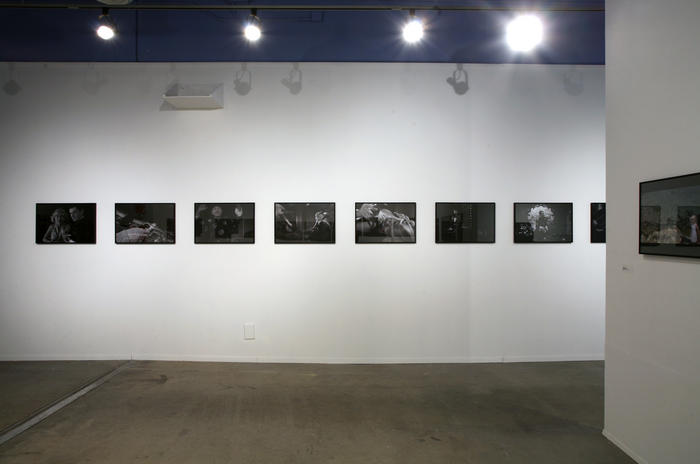
Double Happiness
Lana Ing Gabor
January 11 - February 16, 2007
Opening Reception and Artist Talk January 11












Lana Ing Gabor: Double Happiness
The Chinese character for “double happiness” was created more than a thousand years ago. Some believe that a renowned scholar invented this character to bring added happiness, prosperity, and luck to his sister’s wedding. Others believe that this character first appeared at the wedding of a gifted young scholar and the girl he loved, after she helped him complete the second part of a couplet created by the Emperor to test his mind. Composed of two identical “xi” characters joined side by side, this expression is still commonly seen today in Chinese wedding as red paper-cut decorations. For the artist Lana Ing Gabor, the union of her parents in marriage, a union that fuels her artistic practice.
Furthermore, the title of the exhibition is a play on words which refers to Gabor’s dual identity. Born from the marriage of her Canadian-Chinese mother and her father of Hungarian heritage, the artist examines notions of identity, racial imagery and cross-cultural issues via digital insertions of her image and those of her parents into Hollywood films. Carefully selected for their influential and americanized depiction of Chinese culture as well as for their racial miscasting and portrayal of interacial relationships, these films mirrored the opinions and insecurities of the era in which they were produced.
The Bitter Tea of General Yen (Frank, Capra, 1932) is the oldest of the four films featured that were digitally manipulated by Gabor. Set during China’s Civil War, this black and white film tells the story of a notorious Chinese warlord who falls in love with an American missionary. Allegedly, Capra, unable to find a Chinese actor gifted enough to play the lead role of General Yen, hired Swedish silent actor Nils Asther to do the part. This recurring Hollywood phenomenon of Yellowface, more specifically of Caucasian actors in Asian disguise, has prompted Habor to create a series of stills where her parents play the main roles in this interracial love story. Although a Caucasian in Yellowface, Gabor’s father, still plays the role of General Yen, the American missionary is portrayed by Gabor’s mother, a Canadian-Chinese in Whiteface disguise.
Gabor also intervenes in the classic film Love is a Many-Splendored Thing (Henry King, 1955) through means of a looped video and with images of herself in several stills. The video depicts an American writer, actor William Holden, driving a car through Hong Kong with his love interest, a Eurasian doctor played by Caucasian actress Jennifer Jones. Inspired by the fact that the Hong Kong streets in the scene’s background were actually added by means of green screen, Gabor replaces Jennifer’s caucasian face with archetypal Hong Kong postcard images. In the stills from the Love series, Gabor accentuates her Chinese identity with her choice of traditional dress and makeup and seductively lies in the grass next to the story’s biracial leading lady. In the Splendor series of stills from the same film, Gabor visually splits her two identities and replaces both original actors from their water scene with her Chinese and Blonde Hungarian personas. In both series the artist transforms the actual, sexually charged scenes between the interracial couple to one of ambiguity that suggests several possibilities.
Two other movies in which the artist has inserted herself to change the narrative of the film to overlay them with her own experiences were The World of Suzie Wong (Richard Quine, 1960) and The Joy Luck Club (Wayne Wang, 1986). The former is the story of an American artist (played once again by William Holden) living in Hong Kong who falls in love with a Chinese model-prostitute. The latter is the story of four Chinese friends and their Americanized daughters, who share their life stories filled both with joy and great sorrow.
With the occurence of globalization, differences between races are becoming less apparent and interracial relationships are more frequently seen. However, Hollywood movies and even television shows today still seem to be one step back, as the main characters are usually Caucasian and there is still that feeling of token representation of non-Caucasians in supporting roles, if any. For Gabor, there is still much to explore artistically by way of inserting her own biracial self in Hollywood films to expose truths and to change the story.
- Janelle Dubeau, 2007
Biographies:
Artist Lana Ing Gabor holds a diploma in Fashion Design, a B.F.A in visual arts, and is the recipient of the inaugural Roloff Beny Scholarship. In 2006, her work was included in Current, a group exhibition at the SAAG. Recently, her work was exhibited at the Trianon Gallery with Kevin Ei-Ichi deforest in Eurasialicious, a collaborative show that explored the representation of Eurasian identity in popular culture. She maintains her studio in Lethbridge, AB.
Currently residing in Calgary, Janelle Dubeau works full-time as the Glenbow Museum’s digitization, publishing and rights coordinator, and part-time as a freelance writer for the arts. She holds an M.A. in Museum Studies from the Université du Québec á Montréal, and a B.F.A from the University of Ottawa.
